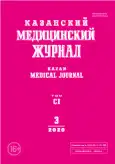Профиль чувствительности к бактериофагам назофарингеальных условно-патогенных бактерий у детей-носителей Streptococcus pneumoniae с рекуррентными респираторными инфекциями
- Авторы: Баязитова Л.Т.1,2, Тюпкина О.Ф.1, Чазова Т.А.1, Конышев Н.С.2, Сюзев К.Н.2, Исаева Г.Ш.1,2
-
Учреждения:
- Казанский научно-исследовательский институт эпидемиологии и микробиологии
- Казанский государственный медицинский университет
- Выпуск: Том 101, № 3 (2020)
- Страницы: 330-336
- Тип: Теоретическая и клиническая медицина
- URL: https://journals.rcsi.science/kazanmedj/article/view/33433
- DOI: https://doi.org/10.17816/KMJ2020-330
- ID: 33433
Цитировать
Аннотация
Цель. Изучение микробиоты и оценка профиля чувствительности к антибиотикам и бактериофагам условно-патогенной микрофлоры носоглотки у детей-носителей Streptococcus pneumoniae с рекуррентными респираторными инфекциями.
Методы. Проведено исследование микрофлоры носоглотки 182 детей с пневмококковым носительством, обратившихся за помощью в Казанский научно-исследовательский институт эпидемиологии и микробиологии. Идентификацию микроорганизмов, оценку чувствительности к антимикробным препаратам и бактериофагам проводили согласно нормативной документации. Выделенные культуры подтверждали с помощью масс-спектрометрии. Для определения титра бактериофага в единице объёма использовали метод Грациа.
Результаты. Пневмококк-ассоциированные таксоны носоглотки представлены Staphylococcus spp., Moraxella spp., Haemophilus spp., Corynebacterium spp., Klebsiella spp и Candida spp. Профиль антибиотикорезистентности Streptococcus pneumoniaе: устойчивостью к оксациллину обладали 20,7%, к эритромицину — 45,9%, к клиндамицину — 20%, к ко-тримоксазолу (сульфаметоксазолу + триметоприму) — 18,4% изолятов соответственно. Мультирезистентность (резистентность к трём и более антибиотикам) обнаружена у 19,6% изолятов. Доля чувствительных к бактериофагам S. pneumoniaе: 97,2% изолятов — к стрептококковому бактериофагу, 75% штаммов — к пиобактериофагу. Все антибиотикорезистентные штаммы были чувствительны к стрептококковому бактериофагу. Титр клебсиеллёзного бактериофага по Грациа в отношении K. pneumoniae варьировал от 9×10–6 до 5×10–5 бляшкообразующих единиц/мл. Результаты ранжирования антистафилококковой активности химиопрепаратов по мере снижения эффективности: фузидиевая кислота ˃ мупироцин ˃ хлорамфеникол ˃ ципрофлоксацин ˃ эритромицин.
Вывод. Микробиоценоз носоглотки детей-носителей пневмококков представлен вариабельной полимикробной ассоциацией, носоглоточные штаммы эффективно лизируются бактериофагами; моно- и поливалентные бактериофаги можно применять в качестве альтернативы антибактериальному лечению у детей-носителей Streptococcus pneumoniae c рекуррентными респираторными инфекциями.
Полный текст
Открыть статью на сайте журналаОб авторах
Лира Табрисовна Баязитова
Казанский научно-исследовательский институт эпидемиологиии микробиологии; Казанский государственный медицинский университет
Автор, ответственный за переписку.
Email: bajalt@mail.ru
SPIN-код: 3981-9173
Россия, г. Казань, Россия; г. Казань, Россия
Ольга Феликсовна Тюпкина
Казанский научно-исследовательский институт эпидемиологиии микробиологии
Email: bajalt@mail.ru
SPIN-код: 3544-6622
Россия, г. Казань, Россия
Татьяна Александровна Чазова
Казанский научно-исследовательский институт эпидемиологиии микробиологии
Email: bajalt@mail.ru
SPIN-код: 6571-0937
Россия, г. Казань, Россия
Никита Сергеевич Конышев
Казанский государственный медицинский университет
Email: bajalt@mail.ru
Россия, г. Казань, Россия
Кирилл Николаевич Сюзев
Казанский государственный медицинский университет
Email: bajalt@mail.ru
Россия, г. Казань, Россия
Гузель Шавхатовна Исаева
Казанский научно-исследовательский институт эпидемиологиии микробиологии; Казанский государственный медицинский университет
Email: bajalt@mail.ru
SPIN-код: 8251-9884
Россия, г. Казань, Россия; г. Казань, Россия
Список литературы
- García-Rodríguez J.A., Fresnadillo Martínez M.J. Dynamics of nasopharyngeal colonization by potential respiratory pathogens. J. Antimicrob. Chemother. 2002; 50 (suppl. S2): 59–73. doi: 10.1093/jac/dkf506.
- Pericone C.D., Overweg K., Hermans P.W.M., Jeffrey N. Weiser inhibitory and bactericidal effects of hydrogen peroxide production by Streptococcus pneumoniae on other inhabitants of the upper respiratory tract. Infection and Immunity. 2000; 68 (7) 3990–3997. doi: 10.1128/IAI.68.7.3990-3997.2000.
- Dunne E.M., Murad C., Sudigdoadi S. et al. Carriage of Streptococcus pneumoniae, Haemophilus influenzae, Moraxella catarrhalis, and Staphylococcus aureus in Indonesian children: A cross-sectional study. PLoS One. 2018; 13 (4): e0195098. doi: 10.1371/journal.pone.0195098.
- Andrade D.C., Borges I.C., Bouzas M.L. et al. Antibody responses against Streptococcus pneumoniae, Haemophilus influenzae and Moraxella catarrhalis in children with acute respiratory infection with or without nasopharyngeal bacterial carriage. Infect. Dis. (Lond.). 2018; 50 (9): 705–713. doi: 10.1080/23744235.2018.1463451.
- Camelo-Castillo A., Henares D., Brotons P. et al. Nasopharyngeal microbiota in children with invasive pneumococcal disease: Identification of bacteria with potential disease-promoting and protective effects. Front. Microbiol. 2019; 10: 11. doi: 10.3389/fmicb.2019.00011.
- Dunne E.M., Smith-Vaughan H.C., Robins-Browne R.M. et al. Nasopharyngeal microbial interactions in the era of pneumococcal conjugate vaccination. Vaccine. 2013; 31 (19): 2333–2342. doi: 10.1016/j.vaccine.2013.03.024.
- Валиева Р.И., Баязитова Л.Т., Тюпкина О.Ф. и др. Микробиота носоглотки у детей-носителей S. pneumoniae с частыми респираторными инфекциями. Сборник научных трудов «Научное обеспечение противоэпидемической защиты населения: актуальные проблемы и решения» Всероссийской научно-практической конференции с международным участием, посвящённой 100-летию ФБУН ННИИЭМ им. академика И.Н. Блохиной Роспотребнадзора (11–12 сентября 2019 г., г. Нижний Новгород). 2019; 257–259.
- Cherazard R., Epstein M., Doan T.L. et al. Antimicrobial resistant Streptococcus pneumoniae: Prevalence, mechanisms, and clinical implications. Am. J. Therap. 2017; 24: 361–369. DOI: 10.1097/ MJT.0000000000000551.
- Hackel M., Lascols C., Bouchillon S. et al. Serotype prevalence and antibiotic resistance in Streptococcus pneumoniae clinical isolates among global populations. Vaccine. 2013; 31: 4881–4887. doi: 10.1016/j.vaccine.2013.07.054.
- Баязитова Л.Т., Тюпкина О.Ф., Чазова Т.А. и др. Внебольничные пневмонии пневмококковой природы и микробиологические аспекты назофарингеального носительства Streptococcus pneumoniae у детей в Республике Татарстан. Инфекция и иммунитет. 2017; 7 (3): 271–278. doi: 10.15789/2220-7619-2017-3-271-278.
- MP 4.2.0114-16. Лабораторная диагностика внебольничной пневмонии пневмококковой этиологии. M. 2017. https://files.stroyinf.ru/Data2/1/4293743/4293743035.htm (дата обращения: 02.04.2020).
Дополнительные файлы







